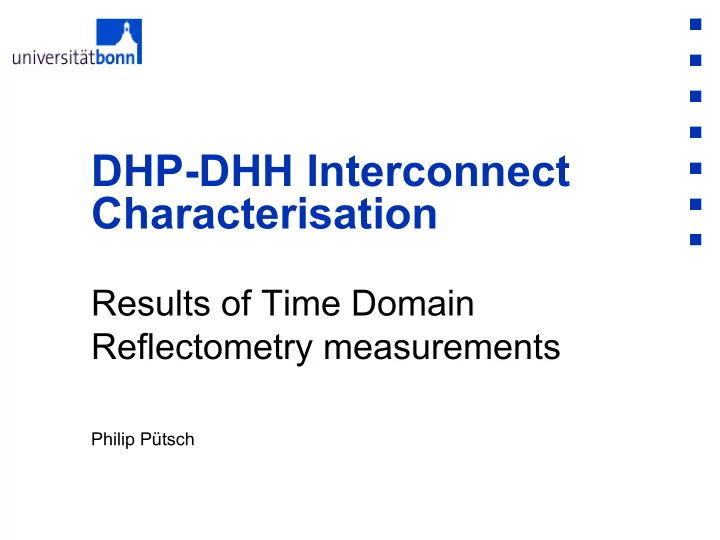

DHP-DHH Interconnect Characterisation Results of Time Domain Reflectometry measurements Philip Pütsch
Interlink Design passive
Challenges of Datatransmission ● 4 Links per Module ● 1.2 Gbit/s per Link, 8B10B encoded -> 1.6 GHz Clock ● Mechanical Situation: Tight constraints near Detector → KAPTON Flex ● Distance DHP-DHH ~15m ● At High Data Rates “Analogue” characteristics are important: ● Impedance: ● Driver ● Transmission Line ● Receiver (Termination) ● Reflections at Discontinuities ● Damping of Transmission Lines ● Noise
Measurement Setup Time Domain Reflectometer ● Time Domain Reflectometry ● Fast Rising/Falling Edge sent to DUT ● Reflected/Transmitted Waveform recorded ● DUT: KAPTON Test Figure, 8 differential Lines, different Trace Width 65u-100u KAPTON FLEX
Measurement Setup II TEKTRONIX TDR & Sampling Scope FPGA Board 12m CAT7 35cm KAPTON Flex
Impedance Measurement
Damping Measurement Frequency dependent transfer function of Kapton cable
Measurement Setup II Sampling Scope RocketIO IN+OUT FPGA
Eye Diagram – RocketIO Output RocketIO driver at the output @2GHz
12m CAT7 + 35cm KAPTON RocketIO driver 12m CAT7 + 35cm Kapton @2GHz
Preemphasis
Preemphasis ● Increase high frequency component of the signal to Compensate the Cable transfer function ● Acts like high pass
Preemphasis II RocketIO driver at the output Preemphasis @2GHz turned on Preemphasis turned off
Preemphasis III RocketIO driver 12m CAT7 + 35cm Kapton @2GHz Preemphasis turned on Preemphasis turned off
Eye DHP DHP 0.1 Driver at the output @ 1.555GHz After 35cm KAPTON
Summary ● TDR Setup to characterise differential electrical Transmission Lines working ● Design and Measurements (Impedance, Damping) match ● Final geometry defined ● 35cm Kapton+12m CAT7 together with preemphasis works ● DHP 0.2 will have preemphasis ● Only passive repeater (Patch Panel) will be needed
Recommend
More recommend